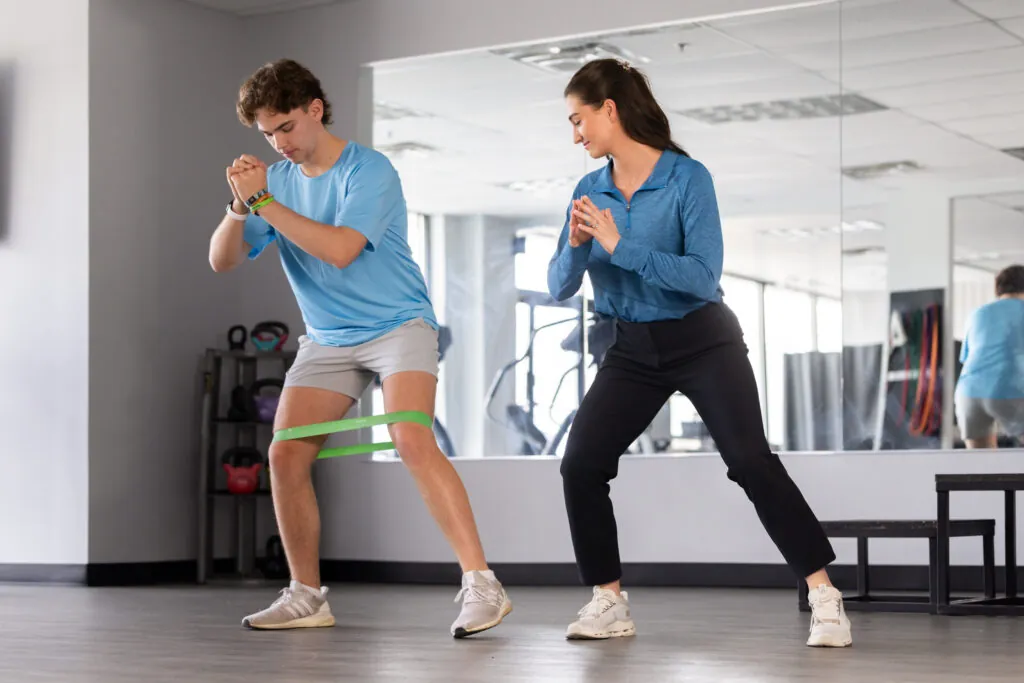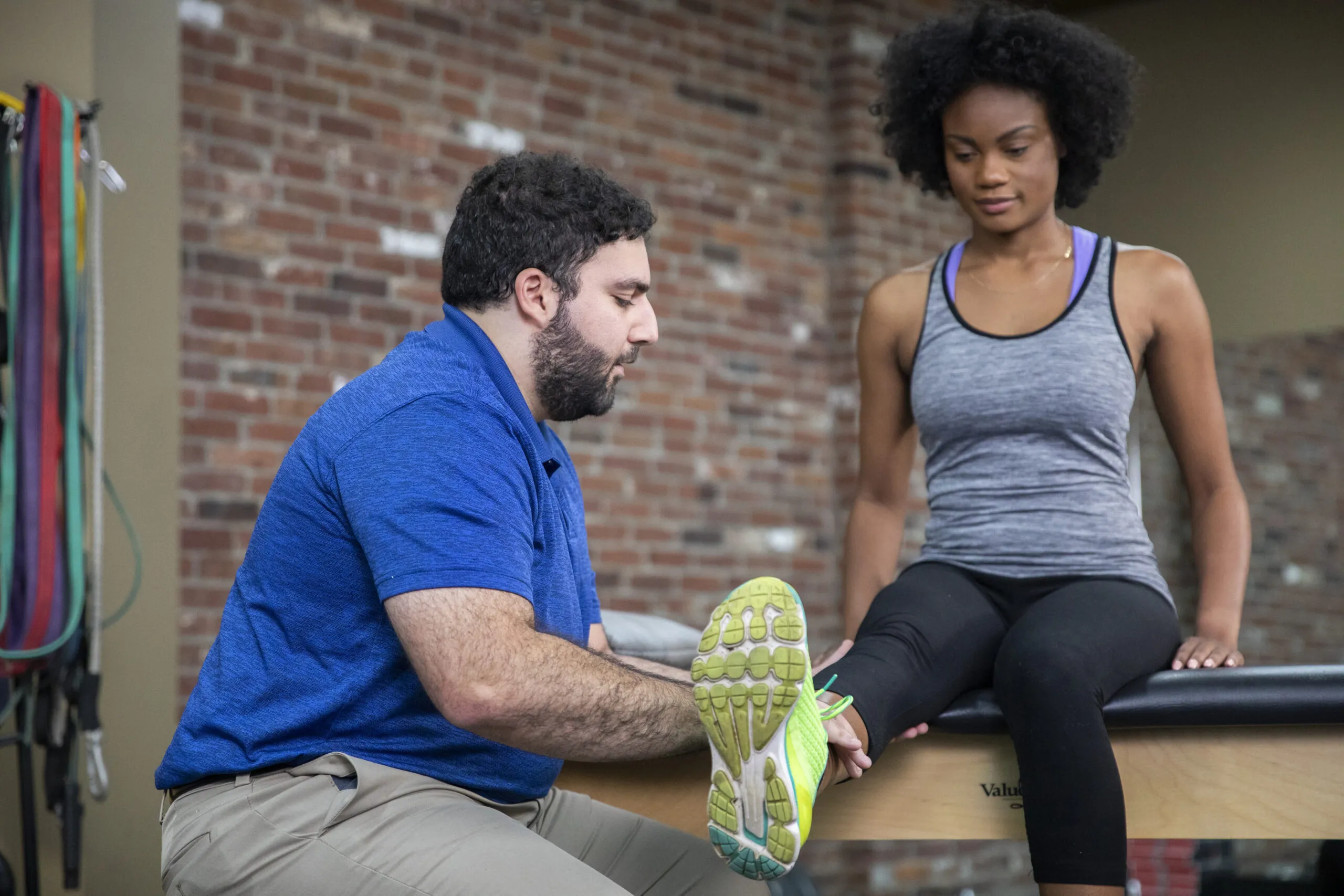[tsf_breadcrumb sep="/" class="breadcrumbs]
Home / Patients / Primary Services / Athletic Training
Athletes looking to take their performance to the next level can benefit from our sports-specific physical therapy programs. We work on improving strength, flexibility, and agility to help you achieve peak performance.
Athletic training is a specialized field of healthcare focused on supporting athletes and active individuals through injury prevention, assessment, treatment, and rehabilitation. As a part of the healthcare team. Athletic trainers provide a wide range of services, including wellness education, injury and illness prevention, emergency care, injury evaluation, therapeutic intervention, and structured rehabilitation programs, all while collaborating closely with physicians and other healthcare providers.1 They work directly with athletes, coaches, and support staff to ensure safe participation in sports and physical activity, enhance athletic performance, aid recovery from injuries, and promote long-term musculoskeletal health. Beyond immediate injury management, athletic trainers also focus on reducing risk of future injuries, optimizing functional movement, and supporting overall health and wellness, making them an essential component of comprehensive athlete care.
The presence of athletic trainers has a measurable impact on athlete health, safety, and recovery outcomes. Research shows that access to athletic trainers can reduce sports-related injury rates by up to 50% by improving prevention strategies and providing early intervention when injuries occur.2 Athletic trainer involvement also improves recovery management. Athletes with consistent access to athletic trainers are significantly more likely to follow proper return-to-play protocols, which helps ensure safer and faster recoveries.3 Furthermore, structured, athletic trainer-led rehabilitation programs have been shown to reduce recovery times by 20-30% for common injuries such as sprains and fractures, while also lowering the likelihood of re-injury by as much as 40%.3
Athletic trainers play a vital role in addressing many of the common concerns athletes face throughout their careers, ranging from acute injuries such as sprains, strains, and concussions to chronic issues like overuse injuries and joint instability. Athletic trainers are often the first to respond when an injury occurs, providing immediate care that can reduce the severity of the injury as well as improve recovery rate. They also design individualized rehabilitation programs to restore strength, flexibility, and function, helping athletes return to play safely and with a reduced risk of re-injury. Beyond physical recovery, athletic trainers contribute to injury prevention by implementing conditioning programs, teaching proper movement mechanics, and educating athletes on wellness strategies such as hydration, nutrition, and recovery techniques. Whether helping an athlete navigate the return-to-play process after a concussion or addressing chronic knee pain from repetitive stress, athletic trainers provide ongoing support that not only protects athletes’ health but also enhances performance and longevity.

As previously stated, athletic trainers are skilled at managing a wide range of athlete concerns, both acute and chronic. The most common include acute injuries such as sprains, strains, dislocations, and fractures, where they provide immediate care to stabilize the injury and reduce further harm. They are also highly skilled in managing concussions, overseeing return-to-play protocols, and ensuring athletes progress safely through recovery stages.3In addition to acute injuries, athletic trainers frequently address overuse conditions that develop gradually with repetitive stress, such as tendonitis, stress fractures, shin splints, and chronic joint pain. These conditions are common among athletes in endurance sports, but they can also affect recreational exercisers and individuals with physically demanding jobs.5
Beyond musculoskeletal concerns, athletic trainers are often the first responders for medical emergencies that may arise during a sporting event, such as heat-related illness, dehydration, or sudden cardiac events. Their ability to provide rapid evidence-based care in these situations is crucial for both short-term outcomes and long-term recovery. They also guide rehabilitation after surgery or significant injury, designing programs that restore function, strength, and mobility while minimizing risk of re-injury.
Athletic trainers serve in a variety of settings where physical performance and safety are priority. These include high schools, colleges, and professional sports teams, where they can focus on injury prevention, treatment, and rehabilitation. They are also increasingly found in clinician facilities, military and tactical units, performing arts, and industrial workplaces, where their ability to manage injuries and optimize physical performance makes them invaluable.4
The benefits of athletic training extend beyond professional athletes. Student athletes gain structured injury prevention and recovery support, while recreational athletes and fitness enthusiasts receive guidance on training safely and avoiding overuse or poor body mechanic related injuries. Athletic trainers also provide value for military personnel, first responders, and individuals with physically demanding jobs, where injury prevention and performance optimization are critical to both health and workplace performance.
Athletic trainers play a key role in helping athletes identify and manage early signs of injury, preventing minor issues from becoming more serious. Common symptoms include pain, swelling, tenderness, bruising, or reduced range of motion (ROM) following acute injuries such as sprains or strains, Athletes may also experience joint instability, weakness, or difficulty performing normal movements, which can indicate more significant musculoskeletal concerns.5
Overuse injuries, such as tendonitis, stress fractures, or repetitive strain injuries often present differently, with gradual soreness, stiffness, fatigue, or discomfort that worsens with activity and improves with rest. These subtle symptoms can be easy to overlook, but early intervention by an athletic trainer can prevent long-term damage and accelerate recovery.
Concussions, a common concern in contact sports, may cause headache, dizziness, confusion, nausea, sensitivity to light or sound, and slowed reaction times. Athletic trainers are trained to recognize these neurological signs and implement structured, evidence-based return-to-play protocols that protect the athlete’s short-and long-term brain health.6
By monitoring and addressing these symptoms properly, athletic trainers not only manage immediate injuries but also support long-term musculoskeletal and neurological health, helping athletes maintain performance, prevent re-injury and stay safe during activity.
Determining whether athletic training is the right approach starts with evaluating your symptoms and activity goals. If you are experiencing pain, limited mobility, recurring injuries, or difficulty performing athletic movements, an athletic trainer can often provide an initial assessment and develop a preventative or rehabilitative plan. In some cases, a PT or physician referral may be recommended, particularly if symptoms are severe, persistent, or suggest an underlying medical condition. Collaboration with a healthcare provider ensures a comprehensive approach and proper diagnosis before beginning athletic training interventions.
Athletic trainers often rely on functional assessments and diagnostic tests to evaluate an injury. These may include ROM measurements, strength testing, balance and stability assessments, and movement pattern analysis. While athletic trainers do not make formal medical diagnoses, these tests help them identify areas of weakness, biomechanical issues, or risk factors that could affect performance or lead to re-injury. They use this information to design personalized training, rehabilitation, and injury-prevention programs.
PTs complement athletic training by performing in-depth evaluations for musculoskeletal injuries. PTs may order or review imaging such as X-rays, MRIs, or ultrasounds to understand the severity and underlying cause of the injury; however, these often are a last resort. They also assess strength, flexibility, joint stability, and functional mobility, which guides targeted interventions that athletic trainers can implement. By combining the expertise of PTs and athletic trainers, athletes receive a holistic plan that addresses both recovery and performance optimization.

Athletic training and physical therapy share a common goal: keeping people moving safely and effectively. Athletic trainers specialize in injury prevention, immediate evaluation, and rehabilitation, often working directly with athletes in real time. PTs, meanwhile, focus on restoring mobility, reducing pain, and improving function after an injury, surgery, or illness. Together, they create a continuum of care that supports both active individuals and those recovering from more complex musculoskeletal conditions.
Athletic trainers are highly skilled in recognizing injuries early and implementing evidence-based exercises and techniques to address them. Their expertise includes taping, braicing, functional movement screening, soft tissue mobilization, and targeted strength or balance training. Just as importantly, they take a proactive approach, building programs designed to reduce injury risk and improve performance so athletes and active individuals can stay resilient.
PTs bring a complimentary skill set, emphasizing recovery and functional restoration. They use manual therapy, therapeutic exercise, joint mobilization, and patient-specific home exercises programs to reduce pain, improve strength, and restore normal movement. Their work extends beyond treating the injury itself, ensuring that patients regain confidence and independence in their daily activities and athletic pursuits.
When athletic trainers and PTs collaborate, the results are even stronger. A PT may coordinate with a high school athletic trainer to ensure a student-athlete’s rehabilitation plan transitions smoothly from the clinic back onto the field. In a clinical setting, athletic trainers often partner with PTs to monitor progress, adjust exercise programs, and provide a seamless return-to-activity plan. This team-based model helps reduce reinjury risk and supports long-term success.
Both athletic training and PT rely on evidence-based practices. From functional strength training and balance work to neuromuscular re-education and joining mobilization, every treatment is rooted in clinical research to ensure it is safe and effective. The goals may differ slightly- athletic training emphasizes prevention, management of acute conditions, and safe return-to-play, while PT prioritizes pain reduction, mobility restoration, and long-term independence-but together they create a comprehensive approach to patient care.
The benefits of this collaboration are clear. Patients and athletes often experience faster recoveries, reduced pain and swelling, improved flexibility and coordination, lower reinjury rates, and enhanced confidence in returning to activity. By combining the proactive nature of athletic training with the restorative focus of PT, individuals are able to move, perform, and live at their best.
For anyone managing an injury recovering from surgery, or seeking ways to move more confidently, pursuing PT is a proactive step towards better help. With athletic trainers and PTs working in coordination, patients can be assured they’re receiving comprehensive, evidence-based care that not only restores function but prevents future injury.
An athletic trainer is a licensed healthcare professional who specializes in injury prevention, assessment, and rehabilitation, often working with physicians and other healthcare providers, such as PTs. A personal trainer focuses on fitness, strength, and conditioning, but does not provide medical evaluation or injury rehabilitation.
Athletic trainers are licensed healthcare professionals who have completed a bachelor’s or master’s degree in athletic training. They are required to pass the Board of Certification (BOC) exam and maintain ongoing continuing education to stay current with best practices in injury prevention.
In many states, you can see an athletic trainer directly without a referral, especially in schools, sports teams, or clinics with direct access. However, athletic trainers often collaborate with physicians for diagnosis or complex medical care.
Each Confluent Health partner has a list of accepted insurances available. To discover if your insurance covers our services, contact the scheduling department of your nearest clinic or speak with your insurance company about in-network and out-of-network providers.
Patients are typically advised to complete 2-3 visits per week over 4-6 weeks. These sessions typically last 40-60 minutes. The first visit is approximately 20 minutes longer to complete the preliminary screening and assess treatment needs.
Most of our clinics and partner locations allow one guest to attend therapy sessions with you. However, policies do vary by clinic, so be sure to confirm this detail when you schedule your appointment.